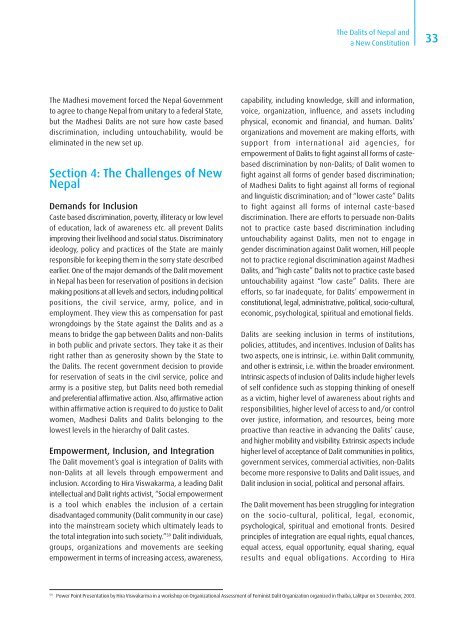The Dalits of Nepal and a New Constitution - ConstitutionNet
The Dalits of Nepal and a New Constitution - ConstitutionNet
The Dalits of Nepal and a New Constitution - ConstitutionNet
Create successful ePaper yourself
Turn your PDF publications into a flip-book with our unique Google optimized e-Paper software.
<strong>The</strong> <strong>Dalits</strong> <strong>of</strong> <strong>Nepal</strong> <strong>and</strong><br />
a <strong>New</strong> <strong>Constitution</strong><br />
33<br />
<strong>The</strong> Madhesi movement forced the <strong>Nepal</strong> Government<br />
to agree to change <strong>Nepal</strong> from unitary to a federal State,<br />
but the Madhesi <strong>Dalits</strong> are not sure how caste based<br />
discrimination, including untouchability, would be<br />
eliminated in the new set up.<br />
Section 4: <strong>The</strong> Challenges <strong>of</strong> <strong>New</strong><br />
<strong>Nepal</strong><br />
Dem<strong>and</strong>s for Inclusion<br />
Caste based discrimination, poverty, illiteracy or low level<br />
<strong>of</strong> education, lack <strong>of</strong> awareness etc. all prevent <strong>Dalits</strong><br />
improving their livelihood <strong>and</strong> social status. Discriminatory<br />
ideology, policy <strong>and</strong> practices <strong>of</strong> the State are mainly<br />
responsible for keeping them in the sorry state described<br />
earlier. One <strong>of</strong> the major dem<strong>and</strong>s <strong>of</strong> the Dalit movement<br />
in <strong>Nepal</strong> has been for reservation <strong>of</strong> positions in decision<br />
making positions at all levels <strong>and</strong> sectors, including political<br />
positions, the civil service, army, police, <strong>and</strong> in<br />
employment. <strong>The</strong>y view this as compensation for past<br />
wrongdoings by the State against the <strong>Dalits</strong> <strong>and</strong> as a<br />
means to bridge the gap between <strong>Dalits</strong> <strong>and</strong> non-<strong>Dalits</strong><br />
in both public <strong>and</strong> private sectors. <strong>The</strong>y take it as their<br />
right rather than as generosity shown by the State to<br />
the <strong>Dalits</strong>. <strong>The</strong> recent government decision to provide<br />
for reservation <strong>of</strong> seats in the civil service, police <strong>and</strong><br />
army is a positive step, but <strong>Dalits</strong> need both remedial<br />
<strong>and</strong> preferential affirmative action. Also, affirmative action<br />
within affirmative action is required to do justice to Dalit<br />
women, Madhesi <strong>Dalits</strong> <strong>and</strong> <strong>Dalits</strong> belonging to the<br />
lowest levels in the hierarchy <strong>of</strong> Dalit castes.<br />
Empowerment, Inclusion, <strong>and</strong> Integration<br />
<strong>The</strong> Dalit movement’s goal is integration <strong>of</strong> <strong>Dalits</strong> with<br />
non-<strong>Dalits</strong> at all levels through empowerment <strong>and</strong><br />
inclusion. According to Hira Viswakarma, a leading Dalit<br />
intellectual <strong>and</strong> Dalit rights activist, “Social empowerment<br />
is a tool which enables the inclusion <strong>of</strong> a certain<br />
disadvantaged community (Dalit community in our case)<br />
into the mainstream society which ultimately leads to<br />
the total integration into such society.” 59 Dalit individuals,<br />
groups, organizations <strong>and</strong> movements are seeking<br />
empowerment in terms <strong>of</strong> increasing access, awareness,<br />
capability, including knowledge, skill <strong>and</strong> information,<br />
voice, organization, influence, <strong>and</strong> assets including<br />
physical, economic <strong>and</strong> financial, <strong>and</strong> human. <strong>Dalits</strong>’<br />
organizations <strong>and</strong> movement are making efforts, with<br />
support from international aid agencies, for<br />
empowerment <strong>of</strong> <strong>Dalits</strong> to fight against all forms <strong>of</strong> castebased<br />
discrimination by non-<strong>Dalits</strong>; <strong>of</strong> Dalit women to<br />
fight against all forms <strong>of</strong> gender based discrimination;<br />
<strong>of</strong> Madhesi <strong>Dalits</strong> to fight against all forms <strong>of</strong> regional<br />
<strong>and</strong> linguistic discrimination; <strong>and</strong> <strong>of</strong> “lower caste” <strong>Dalits</strong><br />
to fight against all forms <strong>of</strong> internal caste-based<br />
discrimination. <strong>The</strong>re are efforts to persuade non-<strong>Dalits</strong><br />
not to practice caste based discrimination including<br />
untouchability against <strong>Dalits</strong>, men not to engage in<br />
gender discrimination against Dalit women, Hill people<br />
not to practice regional discrimination against Madhesi<br />
<strong>Dalits</strong>, <strong>and</strong> “high caste” <strong>Dalits</strong> not to practice caste based<br />
untouchability against “low caste” <strong>Dalits</strong>. <strong>The</strong>re are<br />
efforts, so far inadequate, for <strong>Dalits</strong>’ empowerment in<br />
constitutional, legal, administrative, political, socio-cultural,<br />
economic, psychological, spiritual <strong>and</strong> emotional fields.<br />
<strong>Dalits</strong> are seeking inclusion in terms <strong>of</strong> institutions,<br />
policies, attitudes, <strong>and</strong> incentives. Inclusion <strong>of</strong> <strong>Dalits</strong> has<br />
two aspects, one is intrinsic, i.e. within Dalit community,<br />
<strong>and</strong> other is extrinsic, i.e. within the broader environment.<br />
Intrinsic aspects <strong>of</strong> inclusion <strong>of</strong> <strong>Dalits</strong> include higher levels<br />
<strong>of</strong> self confidence such as stopping thinking <strong>of</strong> oneself<br />
as a victim, higher level <strong>of</strong> awareness about rights <strong>and</strong><br />
responsibilities, higher level <strong>of</strong> access to <strong>and</strong>/or control<br />
over justice, information, <strong>and</strong> resources, being more<br />
proactive than reactive in advancing the <strong>Dalits</strong>’ cause,<br />
<strong>and</strong> higher mobility <strong>and</strong> visibility. Extrinsic aspects include<br />
higher level <strong>of</strong> acceptance <strong>of</strong> Dalit communities in politics,<br />
government services, commercial activities, non-<strong>Dalits</strong><br />
become more responsive to <strong>Dalits</strong> <strong>and</strong> Dalit issues, <strong>and</strong><br />
Dalit inclusion in social, political <strong>and</strong> personal affairs.<br />
<strong>The</strong> Dalit movement has been struggling for integration<br />
on the socio-cultural, political, legal, economic,<br />
psychological, spiritual <strong>and</strong> emotional fronts. Desired<br />
principles <strong>of</strong> integration are equal rights, equal chances,<br />
equal access, equal opportunity, equal sharing, equal<br />
results <strong>and</strong> equal obligations. According to Hira<br />
59<br />
Power Point Presentation by Hira Viswakarma in a workshop on Organizational Assessment <strong>of</strong> Feminist Dalit Organization organized in Thaiba, Lalitpur on 3 December, 2003.








![g]k fnsf blntx? / gofF ;+l jwfg](https://img.yumpu.com/49483602/1/184x260/gk-fnsf-blntx-goff-l-jwfg.jpg?quality=85)



![+ljwfg;ef, /fHosf]k'g](https://img.yumpu.com/41604075/1/184x260/-ljwfgef-fhosfkg.jpg?quality=85)




